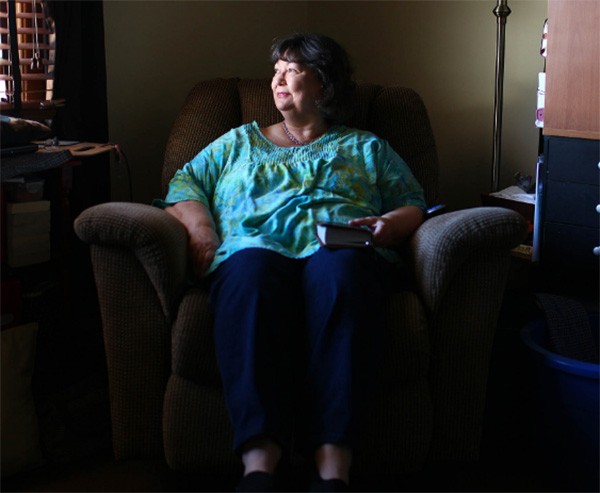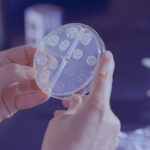The Curse of a ‘None of the Above’ Disease
Ariella Cohen had already made nearly a dozen visits in as many months to a Philadelphia emergency room when, in the winter of 2014, she once again grabbed her pre-packed overnight bag and rushed to the hospital with crippling intestinal pain. She didn’t have high expectations: At just 26, she and her family had seen close to 100 doctors and amassed hundreds of thousands of dollars in medical bills attempting to identify and treat the source of her pain, and she arrived with a long-ago memorized script of the many diagnoses she had received since her childhood.
As she sat on a gurney, Cohen recalls calmly explaining her situation to the attending physician. Like so many times before, her body was in mutiny: The assembly line of muscles along her gut had frozen, and she had been constipated for months, with the resulting pain sometimes scorching her insides. That day it had become so horrendous that she collapsed, prompting two of her regular doctors, fearing that the stoppage might tear a hole in her lower intestine, to advise she go to the ER immediately.
According to Cohen, the ER physician that day simply dismissed her symptoms without an examination. If anything was wrong, he implied, it was mental, not physical, and he refused to admit her. Later that winter, during a raging snowstorm, her agony came again, but despite calling ahead to the ER and being told she could see another physician, the same doctor came around again as she was being examined and told her to go home.

ALSO ON UNDARK:
Worse Than the Disease
A popular therapy for chronic fatigue syndrome made many patients worse. Adding insult to injury, research supporting it is now unraveling.
Undeterred and frightened of the internal damage her untreated symptoms might cause, she made her way by taxi to another hospital 40 minutes away. The staff there was unable to offer any more insight into her problem, though they were able to complete tests to show that she was not in any imminent danger.
As in the past, the attack eventually eased on its own, but it would take six months before she found steady relief from the worst of her episodes, aided by switching to a higher-fat diet.
“It was terrifying,” Cohen told me in January, as I sat with her, her family, and her boyfriend David in the modest apartment she rents with him in Washington, D.C. “This guy just looked at me and decided that because I looked the way I did, I was fine. And if the doctors who sent me were right, it could have been a really dangerous situation.”
“Like death,” interrupted Cohen’s mother, Ellen.
“Right. That,” Cohen said.
Emergency room visits have become a grim fact of life for Cohen. But her encounters with the Philadelphia doctor were hardly unique, she said, and similar skepticism has followed her and her fraternal twin sister Sarah since childhood, when both of them first began suffering from a mysterious array of ailments.
Medical tests proved fruitless. So the sisters were routinely told that their symptoms — ranging from endless fatigue and dizziness to joints that popped in and out of place, along with countless serious allergic reactions — were the psychosomatic manifestation of stress triggered by watching their father slowly die from cancer during their teens, as well as general emotional stress and turmoil.
“The whole culture of medicine is set up very badly to treat people who are unusual,” said Sarah, who just graduated from medical school and whose symptoms have proven to be a bit more manageable than those of her sister. “There’s no time to do better, and we’re not trained to do better.”
The Cohens are among the millions of Americans languishing on the margins of the health care system with elusive or poorly understood diseases. Some of these maladies have names, but each is essentially a collection of unexplained symptoms lumped together by doctors into a sort of diagnostic checklist, often known as a “syndrome.” And while these conditions — which can include chronic fatigue syndrome, fibromyalgia, and irritable bowel syndrome, among others — can vary in severity and treatability, one thing they share is intangibility. They’re “none of the above” illnesses, and they’re surprisingly common.
By some estimates, up to 3 percent of the population suffers from chronic fatigue syndrome, which can range from mild to debilitating. Two to 4 percent, according to the American College of Rheumatology, suffer from the chronic pain and soreness that characterizes fibromyalgia; and upward of 10 percent, including Ariella Cohen, deal with irritable bowel syndrome.
“We need to appreciate just how muddled the concept of medically unexplained symptoms is,” said James Coyne, a professor of health psychology at University Medical Center, Groningen, in the Netherlands. It’s meant to serve as a placeholder for patients who complain of vague health issues that can’t be verified through routine testing or whose cause remains uncertain. But often, Coyne said, there’s a degree of mistrust involved, as many health care professionals prefer psychosomatic explanations for these nebulous ailments.
“In one version of the universe, these things are all objective, concrete disease states,” David Jones, a historian of science at Harvard University, told me. “But there’s another version of the universe, where these things are not diseases as traditionally understood, but rather some kind of psychiatric phenomenon.”
The reality is somewhere in between, recent research suggests, and it’s worth remembering that we’re still a long way from unlocking all the secrets of the brain and body. Only a few decades ago, chronic ulcers were chalked up to stress and diet rather than an infection by Helicobacter pylori, because scientists thought it unimaginable that such microorganisms could endure stomach acid.
As Jones put it, “Even though we have extensive knowledge in human physiology and pathology, there is much that continues to be unknown.”
Coyne is quick to caution that there won’t ever be a single discovery that can explain away every case of medically unexplained symptoms as something physical, complex as they are. But for Cohen and many others who have spent years being sick without knowing why, a new hope may lie in the incremental advances in research that are now being pioneered by geneticists and immunologists.

This research, Coyne explained, is working to identify the genetic quirks and abnormalities in the immune systems shared by some of these people with otherwise unexplainable illnesses. Among the researchers leading the way is Dr. Joshua Milner, a pediatric allergist and immunologist, and his team at the Genetics and Pathogenesis of Allergy laboratory at the National Institutes of Health.
“My lab’s modus operandi is to look for genetic diseases of allergy, so we get referred people all the time who have allergic issues, but then something else that makes it look like it could be a syndrome,” he explained.
In 2015, Cohen was referred to Milner’s team by her dermatologist. Patients like Cohen, suffering from strange allergies and chronic symptoms, began showing up at his lab around five years ago, he said. Aside from their conditions, they shared no common lab finding — except for one oddity. Compared to the average person, their blood was filled with high levels of a protein called tryptase.
Discovered in the 1960s, tryptase is itself something of a mystery. Primarily released by the immune system’s mast cells, it comes in two flavors: alpha and beta, with three subtypes under the latter umbrella. The three types of beta-tryptase largely work as enzymes that keep the immune system’s motor running. They catalyze other chemicals secreted by our cells, called substrates, to induce the inflammation that wards off foreign invaders and — in people with hypersensitivity — causes allergic reactions when triggers appear.
But due to mutations in the gene that expresses it, alpha tryptase has not been shown to interact with any known substrates. Nearly one-fourth of us don’t even produce it, and it has no known function in the human body, at least as an enzyme.
As Milner’s team dug deeper into the genetic makeup of nearly 100 patients from 35 families with elevated tryptase levels, they found all had an abnormally high ratio of alpha to beta tryptase. And they also found evidence that at least one copy of the gene that codes for alpha tryptase was duplicated, even tripled occasionally, in the group.
As the team collected more cases, they saw the same pattern: People with elevated tryptase levels also shared abnormally high alpha to beta tryptase ratios. And the more copies of the alpha tryptase gene they had, the more tryptase they had in their blood, and the worse their symptoms.
Sifting through data from other studies, Milner’s team found the same link between gene copies and high tryptase levels. And when they contacted some of the healthy volunteers who participated in one study, they found that one third of those with high amounts of tryptase and the copied gene had been living silently with many of the same complaints as Cohen, though to a lesser degree.
Eventually, Milner was confident enough to start telling his patients what they had found. “A good number of them cry, because they’ve been told it’s nothing for such a long time,” he said. “They’ve assumed there was something wrong with them personally, not their body.”
Others realized, for the first time, that their symptoms weren’t normal. “I literally had a patient who once told me, ‘Well, of course, when you use a hand mixer, that makes your hand and arm itch,’’’ Milner recalled. “And I was like, ‘No, not for most people.’’’
Last November, the team published its findings in Nature Genetics, dubbing the proposed condition hereditary α-tryptasemia syndrome. While their work hasn’t yet yielded any specific treatments, it at least identified a probable — if barely understood — culprit to help explain the suffering of patients like Cohen.
A few years before participating in Milner’s research, Cohen came across a loose-knit coalition of doctors and patients concerned with disorders of the immune system and the underestimated role they play in unexplainable illnesses. It was her experience with this community that eventually led her to Milner’s study.

Doctors have long known that some people can be sickened by producing too many mast cells in their skin, a rare condition called mastocytosis. These people acquire (or are rarely born with) a mutation that causes their mast cells to clump together and then degranulate, releasing a payload of mediator chemicals that kick the immune system into high gear whenever the skin is irritated by allergic triggers, causing hives and lesions.
Beginning in the early 1990s, a small group of researchers theorized that mast cells could misbehave in another way. Some people, they posited, carry a normal amount of mast cells that are wildly sensitive and degranulate at the faintest whisper of a foreign substance. And because mast cells are scattered throughout the body — not just in the skin — this condition, eventually called mast cell activation syndrome, can cause a wide array of symptoms, perhaps even the kind of mental daze and anxiety doctors might otherwise attribute to stress.
“The immune system talks to the vascular system, it talks to the surrounding connective tissue, it talks to the nerve fibers,” explained Dr. Anne Maitland, an allergist and mast cell specialist with a private practice just outside New York City.
Until recently, people like Ariella Cohen with a hodgepodge of nondescript symptoms were unaware that they might have mast cell issues. (Cohen was diagnosed with MCAS in 2013.) Few doctors were aware of mastocytosis, and fewer still had heard of the emerging field of mast cell disease.
But the Mastocytosis Society, a nonprofit group founded in 1995, has helped to spread awareness by lobbying on behalf of patients and funding research into mast cell disease, according to Valerie Slee, a former pediatric nurse and long-time mast cell disease sufferer who is the current chairwoman of the board of directors.
The group ultimately hopes to persuade the medical establishment that mastocytosis isn’t the only — or even the most common — kind of mast cell dysfunction. In fact, their membership rolls and others’ research suggests that many more people, numbering in the millions, are afflicted with MCAS than mastocytosis.
The group’s efforts have been paying off, Slee said. Even though researchers have known since the 1950s that mastocytosis can turn up anywhere in the body, MCAS was only named in 2007. From there, treatments were developed that reduced symptoms by disrupting the release of mediators like histamine. In 2010, the first diagnostic criteria for MCAS was published, followed by attempts to group all kinds of mast cell disease under one banner.
Thanks in part to organizations like the Mastocytosis Society, as well as networks of doctors including Maitland and Dr. Matthew Hamilton of the Brigham and Women’s Hospital in Massachusetts, MCAS was formally included in the International Classification of Diseases, a codebook established by the World Health Organization, last September. And with that, patients could finally worry less about getting insurance coverage for their expensive treatments.
Broadly speaking, MCAS sufferers seem to share the same fundamental problem as Milner’s patients: a haywire immune system that makes them sick in strange, multiple ways. But any link beyond that remains unclear.
Milner’s patients display many of the same symptoms as those with mast cell disease, yet the overwhelming majority do not have acquired MCAS mutations in their mast cells, nor do most of his patients show the other lab results typical of mast cell activation or mastocytosis. Their issues also run in families, strongly suggesting they’re dealing with an inherited problem, not mutations that pop up later in life.
Most MCAS cases, meanwhile, still aren’t linked to any known acquired mutations. Some in the field suspect we simply haven’t discovered the ones that can explain most cases, while others suspect that infections or other environmental factors could be the initial spark. And though many of Milner’s patients like Cohen were tentatively diagnosed with mast cell issues before they entered his lab, there’s also the possibility that his research is uncovering a completely different sort of systemic dysfunction that merely resembles mast cell disease.
The cold reality is that we still don’t know how alpha tryptase does what it seems to be doing in people like Cohen, or even exactly what it’s doing. “There is scant information about what alpha and beta can and can’t do,” Milner said.

About 5 percent of the U.S. population has high tryptase in their blood, and presumably the duplicated gene. But only some, and especially those whose alpha tryptase levels are tripled, appear to be chronically sick. That makes it likely alpha tryptase isn’t the sole perpetrator.
And alpha tryptase can’t explain everything that’s wrong with the families Milner has studied either. For example, Sarah Cohen has some shared symptoms and conditions with Ariella, like Ehlers-Danlos syndrome, which affects a person’s connective tissue and leaves them with painful joints prone to dislocation, along with fragile skin. But she doesn’t have the gene duplication her sister does.
Most kinds of EDS are tied to a precise inherited cause, but rarely theirs, known as type III, or hypermobile EDS. So it’s possible the alpha tryptase gene explains why some like Ariella have EDS (all of Milner’s patients with EDS have type III), while something else entirely explains Sarah’s condition. “There are certainly families where not everything makes sense,” Milner acknowledged.
Milner is careful to caution that his team’s research into tryptasemia is at an early stage. They are still developing a better test to detect the gene duplication and alpha tryptase, narrowing down which symptoms are associated with high tryptase, and creating a model that will allow them to better study it in mice. And it will be a long time before the first hints of a treatment, like something that can block the production of alpha tryptase, will definitively prove his team’s theory.
But even if alpha tryptase does prove to be a crucial lynchpin, Milner knows it won’t cure all that ails his patients. “I am 100 percent sure that some of the symptoms we see have nothing to do with the gene,’’ he said. “I’m just sure that it’s going to end up that way.’’
Nonetheless, his research offers important relief for patients: for example, the same drug treatments that tamp down immune mediators in the body, like histamine, help both groups of patients. And ultimately, if alpha tryptase is the main instigator for sufferers like Cohen, then a future treatment that blocks its production could be a much simpler remedy.
For all the caveats and conundrums, there is a common thread running through all the research — an awareness that illness is enormously complex and the result of many interconnected environmental, biological, and psychological factors. Stress impairs our ability to heal wounds, and everything from lead metal to parasites can tweak our brain chemistry, leading to personality changes and mental illness.
Even social mores play a part in our perception and treatment of disease: Black people are undertreated for pain in the emergency room, studies suggest, supposedly because white doctors presume they have thicker skin or that their blood coagulates faster; women’s heart issues go unrecognized and untreated to a much higher degree than men’s.
Cohen believes one reason she got such a negative reception from doctors was because of her gender. Many are the women whose complaints of chronic fatigue or other mysterious diseases are still tossed aside as the modern-day equivalent of hysteria, Jones notes.



For their part, the Cohen sisters don’t see mental health as irrelevant to their issues, nor discount the value of psychological care. The problem, Sarah explains, is that it has been routinely offered to them as a way to discount their complaints completely, rather than to help them deal with their stress.
In fact, both sisters have used behavioral interventions like biofeedback, while Ariella regularly turns to holistic and integrative treatments like dry needling to help manage her gut and pain problems. She also credits her ability to eat more foods lately to working with a naturopath. Milner has no problem with his patients trying these strategies out if they think it will help, and at least some of his patients have been able to wean themselves off antihistamines as a result.
Having been entangled in the medical world so deeply for so long, perhaps it’s not surprising that both sisters have chosen to devote their lives toward improving it.
Sarah is weighing a career in pediatric pain management, which would allow her to take on cases of fibromyalgia and other controversial illnesses. “You’ve got to listen to the people who have the experiences,” she said. “Because if you’re going in just from the perspective of a doctor, with blinders on, you end up with the problem we had initially, where doctors just brush it off and didn’t believe us.”
Ariella currently works for the Pew Charitable Trusts in the field of health care products. Unlike her sister, who always wanted to be a doctor, it was specifically Ariella’s life experiences — as a patient, but more so in seeing her father succumb to cancer — that motivated her to pursue a career in health law.
“I not only had to watch my dad pass away, but also my mom fight with the insurance companies on a daily basis to get them to cover his treatments,” she said. “That gave me insight into the incredible problems with our insurance and health care system.”
One problem in particular is the difficulty MCAS patients have in affording their drugs. Even with the new ICD-10 codes, some medications aren’t approved by the Food and Drug Administration to treat mast cell diseases. As a result, doctors are often forced to write appeals for patients to insurance companies to get coverage. Other drugs need to be custom-made at specialized pharmacies to avoid allergic ingredients, and these drugs — including many of the 40 to 50 that Ariella takes every day — are often not covered by providers.
“There are a lot of hurdles in place regarding the lack of recognition by health care providers, a lack of education of patients… lack of commercial testing,” said Maitland, the allergist and mast cell specialist. “Patients are grabbing onto us like driftwood in the middle of the ocean.”
Though she is encouraged by the advances in the field, she notes there are only three major medical centers, including one at the NIH, where mast cell issues are easily diagnosable. For private doctors like her, the waiting list for patients can stretch on for six to eight months, and due to New York’s licensing laws, she added, she can’t even use one of the only six commercial tests developed for MCAS. “It’s a lack of awareness that is slowly changing,” she said.
As for Milner, he hopes his tryptase research will provide his patients with validation and direction, and in the process eventually shrink the number of patients tossed into the miscellaneous pile.
“The genomic era helps us say, actually there is something there that may or may not change the way you would deal with the person, but at the very least, there’s a gene there,’’ he said.

Aside from her intestinal flare-ups, Cohen continues to deal with a startling number of allergic triggers she has to avoid: soy, garlic, the metal found in IVs, alcohol, chlorine, nightshade plants like potatoes, most perfumes, raw produce, anything found in a Chinese restaurant, cobalt, and gluten, to name a few. She estimates there are just 35 foods she can safely consume. And that tally includes different varieties of squash, sweet potatoes, and spices.
“I go through phases where I can’t eat anything, or I lose the ability to eat my staple food, and I have to figure out what else in the world is safe,” she said. The week before our interview in January, she made an emergency room visit following a severe reaction brought on by garlic her boyfriend had eaten. In the months after, she had six such attacks within a two-week span.
Despite her struggles, the years since Cohen’s MCAS diagnosis in 2013 and her subsequent participation in Milner’s study have at least given her some assurance that she isn’t alone.
With the help of a dedicated team of physicians and practitioners who regularly communicate with her and with one another, she has gradually learned to identify and manage her symptoms. And with her boyfriend David around, she even goes on regular hiking trips, something she never would have considered in the past. “It’s easier to do something fun now, because I feel safe that if something were to go wrong, I have him,” she said.
That added security, combined with a hard-earned resilience hidden underneath her short, wiry frame, makes Cohen willing to become a spokesperson for others like her.
“I think it’s important for people in my situation to tell the world what this life is like, because maybe a doctor will see this and change their ways,” she said. “Maybe a patient will see this, and think, ‘Oh my god, that’s exactly my life.’ And maybe that’ll help them find some answers.”
At the same time, she doesn’t want pity, nor to be defined by her illness alone.
“Every stage of my life, it’s always like, ‘How the hell am I going to get to this next stage? How will I actually be able to do the things I want to do in life?’” she continued. “But I always get there. It’s just harder for me than it is for everyone else.”
Ed Cara is a Brooklyn-based journalist who has written about psychology, sociology, and public health for a variety of publications, including The Atlantic, Pacific Standard, Vocativ, and Medical Daily.











Comments are automatically closed one year after article publication. Archived comments are below.
My husband’s trypatase has never been tested until 2019 and it is between 55 and 58 all of the time.
No allergies.The only thing he has is psoriasis on his legs and elbows. I don’t know if a connection that nobody has figured out yet..My husband’s hemoglobin is high 18 to 21 and hematocrit 52 to 58 depending on how often he gets phlibotomies. Tested for polycythemia Vera and jak 2 negative. Mastocytosis was suspected in the bmb. But docs say no he hasn’t got that. I’m scared and we soon have to get a new bone marrow biopsy. Now doctors think maybe some c h.i.p clonal hematopoietic indeterminate thing. We live in USA NC. My husband is 59 white male and smokes.
I have been diagnosed with Bechet’s disease, an autoimmune vasculitis. Like most of you, I spent b years being referred to psych docs because there were no obvious clinical abnormality. Years being told I was crazy, and I believed them. You’re supposed to be able to trust your doctor, right?
Bechet’s is a diagnosis of exclusion; I had 5 other autoimmune diagnoses which were then ruled out one by one. I am almost certain that I don’t actually have Bechet’s, but I’ve lost faith in the medical profession and am tired of test results which read “findings of unknown significance” that only lead to more questions, more tests.
The thought I would like to add regarding being dismissed out of hand has to do with socioeconomic status. I live in the United States, and I am on SSDI. My insurance is through the government, via Medicare. Medicare pays approx 30% of what a medical facility generally charges on covered services. For hospitals trying to meet the bottom line, it doesn’t profit them much to start down the rabbit hole of a complex chronic disease. However, thanks to a grant from the department of health and human services, mental health and substance abuse diagnoses are covered at a rate of 40% to 60% of the going rate. I applaud the initiative to make sure physicians are more aware of these serious issues, but giving facilities yet another incentive to move us into the “crazy” catagory is a huge step in the wrong direction.
Interesting, I was diagnosed hyper mobility and fibromyalgia over 30 years ago. Nothing helped the pain. now my daughter and grandchildren are diagnosed EDS, hyper mobile type. They have the bowel issues, in fact my own symptoms have been less troublesome than theirs. Daughter has been on thyroxin since age 21,due to autoimmune antibodies. I have them too, the hashimotos thyroiditis, but the annual blood test raised the bar for treatment of under-active thyroid, even though have been symptomatic for around 30 years. The issues seem to be getting worse in each generation, grandchild had ‘dodgy’ blood test result at age 6 ignored by the pediatrician, two years later, she was so symptomatic it could not be ignored and she is on low dose thyroxine. Daughter has ME /CFS, but also auto immune idiopathic thrombo cyto penia. ITP, where her blood platelets drop and she bruises stupidly easily, her HB drops, her white blood cell count drops. There are so many co-morbid conditions not yet fully explored. they have family history of osteo porosis to look forward to by my age…..
Ron Davis, who won a Nobel prize for his work on the Human Genome Project, is currently doing in-depth genetic analysis on ME”CFS” patients at Stanford and finding numerous genetic abnormalities. Unfortunately, his son Whitney is so severely ill with ME that he has been fully bedbound for several years. Whitney is so sick he is unable to speak. Most people are unaware that ME”CFS” can be that severe, and even at that severity level there are currently no FDA approved medicines. Even our sickest ME patients have been labeled psychosomatic, and in Europe they sometimes get sectioned into psychiatric hospitals against their will. There are doctors holding onto their conversion disorder and psychosomatic theories in the face of many hundreds of studies proving biological abnormalities. At a certain point, you have to start wondering if those doctors are suffering a form of mental illness themselves, that they would be willing to discard science and stick with how they “feel” about these conditions. Not unlike many people like our friend Neil here in the comments section. If doctors, or anyone, chooses to suspend their disbelief long enough to do a simple Google search, they will find the physical evidence.
Now, the real challenge we face is getting the NIH and CDC to take these diseases seriously enough to fund medical research equal to the level of physical debilitation and fiscal burden on our economy these diseases are causing. ME”CFS” still remains at the very bottom of the priority list if you compare it to the level of funding of other similarly debilitating diseases like MS.
My struggle with MCAS involves materials and clothing. If anyone has any insight, feel free to comment. I can’t touch any materials without getting hives. It started after I was exposed to breathing a lot of chemicals after a fire, and I had unknown Lyme disease. I have very little clothing I can wear, and generally am having to make my own clothes out of any material I can touch. This is all under investigation now.
Great article, that is helping raise awareness.
For those with Ehlers Danlos Syndrome, EDS typically has 2 conditions that travel with it, mast cell dysfunction (since the mast cells are “embedded and educated” within their local community/ microenvironment of cells and structures) as well as peripheral nerve dysfunction (nerves and mast cells “cross-talk” within the tissue all the time).
As practitioner, I had to open my eyes and “unlearn” what I was taught in medical school, residency and fellowship, to “see” mast cell action beyond “allergies”.
Doctors need publications to bring into focus new ideas and consider different approaches. Suggestions for practitioners who are willing and able to work with you, Seneviratne SL, Maitland A, Afrin L. 2017. Mast cell disorders in Ehlers–Danlos syndrome. Am J Med Genet Part C Semin Med Genet 9999C:1–11 and Theoharides TC, Valent P, Akin C. Mast cells, mastocytosis, and related disorders. N Engl J Med 2015;373:163-72.
This triad of co-traveling illnesses needs a team effort, with you and a motivated health care practitioner as co-pilots, steering through diagnostic mazes and a plethora of therapeutic treatments, including nutrition (which was an elective during my med school days), stress relief, as well as allopathic and “complementary” therapies.
For more guidance, along with the Mastocytosis society, also consider ED National Foundation (EDNF), dysautomonia international – patient friendly societies that are now working together. It was patients coming through my practice that opened my eyes years ago and share pearls to help others and make “it medicine for someone else”.
Salud!
Anne M.
2 years ago I was dying from the cumulative, unbearable stress of a degenerative skin condition in my facial tissue variously diagnosed as rosacea/atopic dermatitis (doctor “I dunno” words) over the 11 month ordeal. At it’s worst I was cycling between raw hamburger and a crust that itched beyond anything you could imagine. Very temporary relief was won only by steroids but the condition would return quickly. (Condition began most likely from the accidental single-dose use of a long-expired tube of Retin-A).
Once the syndrome was embedded and I sought medical attention I found everybody wanted to blame me for using some topical that must have worsened things to the point they were. Total lack of restful sleep was going to finish me off from immune collapse (I know a lot about challenged immunity from my experiences as a substitute teacher getting clobbered with RSVs from getting sprayed by little kids). Generally compromised immunity is a story unto itself, as it can develop from cumulative stress from many sources.
Halfway through the experience I asked my regular MD about fasting. He reacted almost violently and dismissed the idea in the strongest terms. Months later I reviewed the research of Dr. Valter Longo at USC who has gotten some attention looking at fasting/caloric restriction in anti-aging–he theorizes that fasting “re-sets” the immune system giving you a new set of immune stem cells. I went on a fruit juice AM veg. juice PM regime and the 3rd day the oozing fissures in my face sealed up. The itchy margins of the patchy skin gone by the 5th. The first normal all-over complexion in almost a year by the 7th and final day of the fast (I corresponded with Dr Longo and he was starting to use a 4-day veg juice protocol with patients whose conditions were similar to mine).
In the nearly 2 years since I have monitored a strict rotational diet procedure and identified “trigger” foods that tend to bring the inflammation back (dairy the worst offender, though apparently there is something to the gluten factor for me at least as the last thing removed was beer which does have gluten though there are some new products available that don’t). I always had greasy acne-prone skin (why I was on the Retin-A topical) and that problem persists; but the over-all hellish inflammation is no longer an issue (two subsequent eruptions from offending foods–dairy and grains-were suppressed with brief fasts).
So for what it’s worth there’s my “orphan malady” experience. The web sources say things like “16 million with Rosacea” and who knows how many with dermatitis, in any event if you find yourself written off by the regular MDs (signal is when they start prescribing expensive tests they didn’t offer in the first place) you might try a fast, it is after all free.
Going through the same thing after exposure to construction dust /mold. 3 years into the illness and research, same conclusion. Finally more literature and medical research.
Neil…and like minded peeps,…. I am not going to join the tirade of why you’re wrong ..or part of the problem..or are unaware of the realities regarding unknown syndromes. I will just ask you to consider this.
The medical profession is of course dealing mostly with adults on this issue. But that is likely not because of malingering..but simply the result of desperation. I am a 47 year old with type 3 eds..and a host ofcthings that go with it. My dagnosis and subsequent family diagnoses came after mt then 7 yr old had spent the best part of 18 months in hospital. And heres the thing
though that I want to emphasize…..
It is not psychological when a child gets down out of a tree and leaves her freinds to come inside and deal with pain. Its not attention seeking when they intuitivly decide its better to sit on the side of the tramp and watch their freinds instead of jump with them. Its not and emotional or psychological trigger that causes them to say theyre not hungry at a birthday party- when you can clearly hear their tummy growl – but a growing awareness that they food offered is going to make them feel sick. At such a young age they just adapt there behaviours instinctivly. Liking prefering a solid heavy leather school shoe that they can lace up tightly instead of a jogger. They dont know that theyre “strapping” a highly mobile joint. They just know it feels better. It begins like this and then becomes an instinctive pattern. So by the time we as adults are presenting in emergency rooms..we are at the point where adapting..and modifying no longer works. Where we cant self manage anymore and arexdesperate for relief. When that then 7 year old – who is now 12 -puts enemas on the grocery shopping list we quietly acknowledge that she is self managing her non working bowel quite well. The fact that a little girl woukd rather self administer as required than go to a gp or hospital and hear yet again that she isnt drinking enough water etc … is absolute proof that there is no malingering or emotional basis to her presentation of “undiagnosed “.pain.. The point I want to make most clearly is that -as adults-we have the realization that we need to verbalize our issues to medical specialists when asking for help. But invariably they were childhood conditions we were trying to manage and live with prior to our arrival in emergency . And appkying adult causes stress, and anxiety etc is not onky irrelevant but way of base..
I can tell you that irritable bowel syndrome (IBS) is no joke. And I do know the cause – my gut bacterial biome. After a serious surgery where I was hit with a massive amount of intravenous antibiotics all of my IBS symptoms went away for 15 months. They are now back.
You’re damn right. Mark Pimentel and his team in Cedars-Sinai have shown that SIBO(small intestinal bacterial overgrowth) is the most commom AND! treatable cause of IBS! Antibiotic rifaximin works wonders for so many people. So much for psychosomatism… there’s even a blood test for that!
Did anyone get how a high fat diet helped this poor woman? I am suffering from similar digestive issues and recently tested positive for the hereditary alpha tryptesemia gene.
I am sure that the suffering described is genuine. I am concerncd however, that this is as much a symptom of modern life in the age of information. I feel that many “syndromes” of the auto immune variety are indeed psychological in nature. Confirmation bias and the availability of reassurance via the Internet certainly could be magnifying issues that humans have dealt with for centuries without complaints. Lack of acknowledgement of simple discomfort due to the presence of much greater existential threats, like axe fights, or dying from the flu. Those things are gone (for the most part), and when all the monsters are extinct we must invent them. Not to mention simple malingering.
Neil, clearly you don’t suffer from one of the “none of the above” maladies or you would extend a little more compassion to a very large group of people who, I can assure you, aren’t looking for attention or trying to create their own maladies. There’s an epidemic of autoimmune diseases for a multitude of reasons that, as the article states repeatedly, we don’t fully understand yet. To assume that people are creating these issues for themselves out of boredom or psychological need is to propagate the continued dismissal of their symptoms. No one who falls into this “other” category enjoys going from doctor to doctor and spending a large chunk of their income on doctors who shrug their shoulders or refuse to acknowledge there’s a problem simply because the tool to measure the problem hasn’t been discovered yet.
I apologize if my comment came across as flippant. I was just trying to make the point that the acknowledgement of a psychological etiology is not the same as mental illness. Psychological stress and the immune system are so closely intertwined that those whom point to it as a root of these problems should not be characterized as dismissive and heartless toward patients.
Neil it’s people like you and your theories that make us feel devastated! We have many symptoms but ignorant people who think we are malingering is the worst!
I’ve had 3 lower back and neck surgeries, 3 shoulder surgeries, severe osteoarthritis, Fibromyalgia, myfacia syndrome, chronic pain all over my body! I have for over 20 yrs done my best to just get on with it!
Now I can no longer hide it, Fibromyalgia is severe pain where no injuries occur! The brain is not getting right signals I could go on but I am so tired both mentally and physically to repeating this over and over to people who have already made their minds up that there is nothing wrong with us !
The American Medical Association has declared Fibromyalgia as a medical issue not pshycosematic or hypochondriac ….
I am unfortunate that most pain Meds does not work ! I take percocette to at least get the edge off ! I am maybe 10 IIb overweight and it’s hard! As excercising is out …
I can do very little but try to do some!
For anyone mentioning fibromyalgia, mine and so many others’ fibro has turned out to actually be Lyme disease, a bacterial infection. I had a known tick bite that started mine off. It took 18 months after the tick bite for full-blown fibro to occur – that’s pain all over the body. When I found out 25 years later this was Lyme disease, 150mg clindamycin 2x/day worked to stop that pai for 5 years. Now I take turmeric capsules to take down that pain. We’re all different in what we respond to. More info at www lymenet org.
Well said.
You do not know what you are talking about.
Frankly, it’s hard for me to imagine how exactly an anaphylactic reaction could possibly be ignored, even in the middle of an axe fight.
Neil, I think it’s indisputable that stress plays a role in our health, but I found your two posts contradictory.
Your second post implies that great stress can cause certain illnesses, but your first post asserts that great stress prevents debilitation from chronic illness.
Can you clarify / correct / restate (as appropriate) your view of the role of stress in development of chronic illness?
Neil, I see this point made so often that I’m a bit tired of it, but I’ll try to explain. The reason people go to doctors to look for answers is not because they don’t have anything better to do! They hate to go from doctor to doctor, they hate to wait in queues, they hate to keep telling the same thing and getting the same answer. They DON’T WANT ATTENTION. They wish that they could be just like everyone else with some mild physical complaints which don’t really affect their lives. The problem is, there’s still so much we don’t know in medicine, it’s unbelievable, we’re only scratching the surface with chronic disease, yet most doctors pretend to be “know-all” and think they can label you whatever they think would get rid of your face. I highly suggest you read this beautiful article so you would understand what HISTORY can teach us (https://mpkb.org/home/alternate/psychosomatic). Unfortunately, most doctors don’t give a damn about history. The main problem I see is inability to embrace uncertainty and inability to understand how much harm you do when you label someone as having a stress induced illness versus some physical cause when it isn’t stress that caused it. And I can assure you, it isn’t stress in a huge majority of cases, but doctors look at it like it’s the other way around. Guilty until proven innocent. It hurts really bad, it hurts just as much as an illness itself. We should learn to say “I don’t know”. We should be able to say “Medicine is not there yet”, etc.. but their egos are too big for that, I guess…
I will finish with a famous quote:
“Those who don’t know history are doomed to repeat it”
I have suffered from fibromyalgia since I was a small child. At age 6 the doctor instructed my mom to put an adult aspirin in a spoonful of jelly so I could swallow it, as baby aspirin no longer addressed my pain. Four years ago I got Lyme disease that was inadequately treated and since then my symptoms have gone off the charts.
I have heard every version of “it’s your imagination” there is. I’ve had many doctors tell me it’s all in my head, I just have to learn to live with it, It’s “just” depression. Here’s what I tell them: I am an artist, musician, and a highly creative and passionate individual. When I’m in a months-long stretch of pain and fatigue, I can have a project that I’m highly enthused about. And yet, when I begin work, I am struck by intolerable fatigue and end up back on the couch. Then I try again and again, with the same result. I do not have the depressive symptom of disinterest in the world and lack of motivation. But after months of getting slapped down by pain and fatigue, I begin to feel helpless and hopeless, and yes, THAT’S DEPRESSION. So yes, it’s depressing. And no, that’s not the cause.
After literally years of having my symptoms dismissed and being refused referrals to ANYONE ELSE, I changed doctors. My new doctor ordered adrenal testing on my first appointment, and I was diagnosed with Adrenal Fatigue Syndrome, and vasovagal syncope (which I’ve also had all my life). I am receiving hydrocortisone therapy, and it is helping.
BUT I LOST YEARS OF MY LIFE BECAUSE OF A DOCTOR WHO DISMISSED MY SYMPTOMS AND REFUSED TO ORDER TESTING.
Neil, when I read your comment I felt like the breath was knocked out of me. You are trying to make sense of something you have obviously never experienced nor completely researched.
This outside “opinion” is exactly how people with immune conditions, CFS, fibro, mitochondrial disease, undiagnosed subclinical thyroid system dIsorders, etc have gone so long receiving insults on top of injury trying to get help in our current medical system.
Mentally and emotionally it is incredibly traumatizing.
The sooner that both the public and medical practicioners alike shift gears, and open up at least to the possibility we don’t have the full picture yet, the less isolated and marginalized people with these conditions will be. What is frustrating is that ideals seem slow to change even in the face of new evidence.
It is disappointing that too many physicians aren’t keeping up with the new info, and/or insist on hanging on to old and unscientific prejudices.
Only someone who has lived this can even begin to understand how heavily these types of conditions impact ones ability to live a “normal” life, and how desperately people want thier lives back. No amount of rallying ones will, or positive mental projections stop the cascade of imbalance in an immune/biological system gone awry.
Because it was easier to sluff patients off by naming various psychiatric conditions as the CAUSE, (and certainly depression CAN be the RESULT) and because of the belief that some difinitive diagnosis was better than no diagnosis, (howebeit the wrong diagnosis), sufferers have been in decades of medical limbo, have been traumatized by blind judgements from people who take an oath to do no harm, who most of us go to see as the last resort, after all we can do, and because of this blind approach, monies for research have not been funneled where they decades ago should have been.
It’s high time to recognize and acknowledge the archaic way in which these illnesses have been and continue to be managed.
I am thankful for the rise of functional medicine and Naturopathic Doctors. It’s been a saving grace for many people who are not yet being helped by traditional medicine.
Very interesting! I have Dercums disease and went through years of being put through duplicate tests and being diagnosed with many other “syndromes” along the way.
Currently waiting for an appointment with the geneticist. Can’t wait to see what shows up.
37 years of being told by dozens of doctors my neuro and immune symptoms were all in my head. 3 dozen worthless psych medications.
Psychiatrists pretended to help while I lost my ability to do math, read, and walk without stumbling. I couldn’t reliably remember my phone number or home address. Doctors, after standard blood tests returned normal, just kept referring me back to psychiatry.
What finally helped was not yet another antidepressant, but getting a correct diagnosis and treatment to minimize my disease symptoms.
I am a white male. But after enduring nearly 4 decades of medical disbelief and misdiagnoses, I have difficulty agreeing with the article narrative that race and gender have provided some kind of advantage in dealing with doctors.
The problems of the medical profession dealing with a “none of the above disease” transcend both gender and race.
I am a white female. I was diagnosed with Reflex Sympathetic Dystrophy within 2 weeks after acquiring it, which is extremely unusual. I was sent to a female Specialist who dropped me in 3 months, she was useless. I went to a different specialist in 6 months who started treating me correctly and a 3rd specialist who actually put the RSD to sleep for 7 wonderful years. Once it was put to sleep, I discovered I also had Fibromyalgia, degenerative disk disease and spondylosis, 5 herniated disks, complex chronic migraines and several autoimmune diseases. The RSD hid all of them. Fibromyalgia hides many autoimmune diseases and doctors often don’t tests for them and so they label you with Fibromyalgia instead. I don’t think I was treated differently because I am a white female, I guess I won’t allow it. I also realize I pay the doctor and so they pay me. This article may help some people, but I think it is only a very few of the people with Fibromyalgia. I think a lot of people with Fibromyalgia are misdiagnosis, but I also think that Fibromyalgia is a combination of many things and not just one thing. I think one very large thing is helping Fibromyalgia patients is improving their nutrition and no one seems to be stressing that enough except the one sister.
Hi John,
I’m in a similar position to you, so I understand your thinking. I’ve been told to suck it up, not something you want to hear from a doctor. I’m still in the stage where I’m being referred back to shrinks to talk about my mental health and not my physical and debilitating health. The thought of suicide entered my mind for the first time when being told that there was no more that could be done for me other than talk therapy and antidepressants. I was told I had to accept that this is my life now. I accept that this could be my life now, but not that there’s something wrong with me psychologically. Funny, that in that moment after all my years of perseverance, taking part in what ever was offered, optimism, my mental health finally took a turn for the worse. It’s almost as if they want us to give up, give in, and admit it’s all in our heads. That’s the depressing part, that’s the part that had brought me to the point where I considered ending everything.
Not feeling so glum today though. I’m back to my optimistic self and I hope you’re finding yourself a road to better health.
Could I ask, what were you eventually diagnosed with? I have to wonder if you and I share more than just our experiences.
All the best to you John.
Mcas as far as I know runs in my family. My children and I have EDS type 3 and it is common for eds patients. I have not been formally diagnosed with this as I don’t have the ability to pursue this but I have had lifelong problems with all antibiotics, dental work,and as I have gotten older it had spanned into chemicals in the household,perfumes, ammonia,peroxide, car fumes, paint,nail polish dust mites,other insect debris and anything containing mercury including the air near the ocean. The list is endless except foods that don’t contain chemicals. These reactions are what lead to the genetic Dr and the diagnoses of EDS. There is also a variant to the SLC2A10 gene responsible for transport of glucose,vit c,and chemicals across the cell wall. There is a Dr in Belgium studying these patients as carriers of ATS and the disease ATS and they are having their first ever clinic for these patients of ats and the carriers of ats.
I’m another EDS III patient, and I got there after several misdiagnoses, like so many of us. I work, I go camping, I have a life. But I do it with constant chronic pain and I’ve learned to hold my face straight so that nobody can see and be distressed when it suddenly ramps up (say, after I walk up a step). So you’ll never know what I have unless I tell you, or you see my face in an unguarded moment and inquire. Or I dislocate something right in front of you, I suppose.
I don’t blame the doctors who tried and failed to diagnose my disease. It’s not well-known, really. But I do blame the occasional doctor who dismisses my pain as either not real or not important, and who refuses to lift a finger to help me manage it better. I know I can’t be cured–but surely something can be done on the pain frontier. At the moment nothing works, not Tylenol or ibuprofen–and that’s what they keep recommending me.